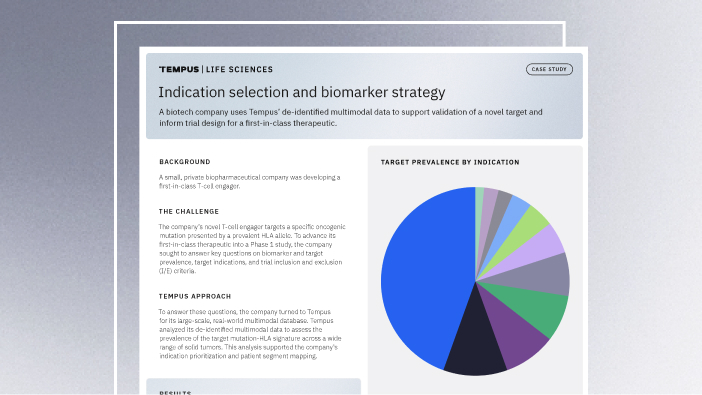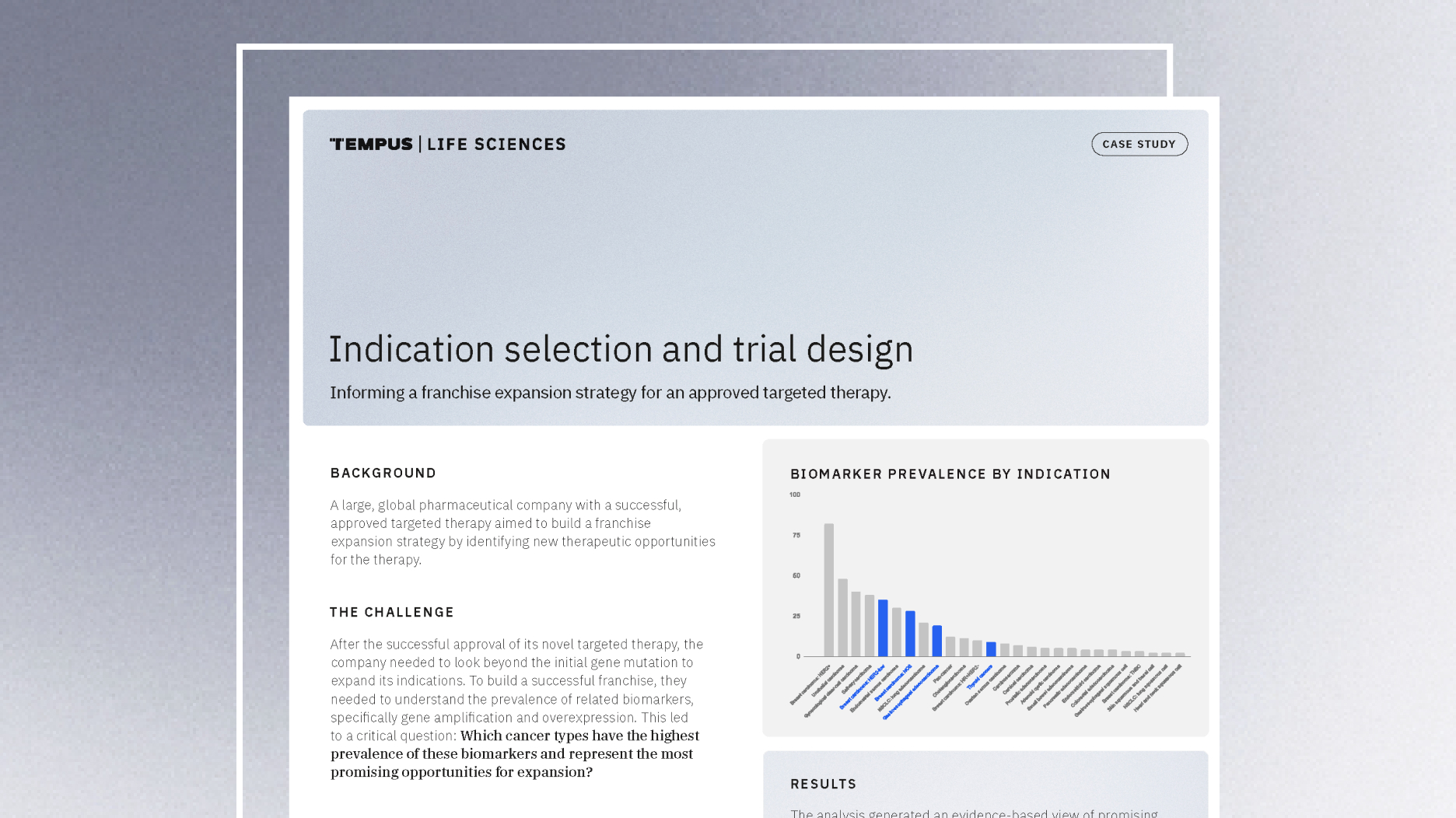-
PROVIDERS
New MRD Medicare Coverage for Select Indications*
*When coverage criteria are met. Additional criteria and exceptions for coverage may apply.
-
LIFE SCIENCES
REGISTER NOW
UPCOMING WEBINAR
Driving enterprise value with RWD -
PATIENTS
It's About Time
View the Tempus vision.
- RESOURCES
-
ABOUT US
View Job Postings
We’re looking for people who can change the world.
- INVESTORS
11/21/2024
Q&A: A deep dive into the science and significance of Tempus’ Immune Profile Score (IPS)
In this Q&A, Dr. Michelle Ting-Lin, Medical Director of Clinical Development at Tempus, provides insights into the science behind the Immune Profile Score (IPS), a novel biomarker designed to enhance the identification of patients who may benefit from immune checkpoint inhibitor (ICI) therapies.
Authors
Michelle Ting-Lin, MD


Dr. Ting-Lin discusses the challenges in current biomarker methods, the robust validation of IPS, and the potential of this tool in both research and clinical settings.
Can you start by telling us about your background and role at Tempus? |
| Ting-Lin, MD: I’m a board-certified pediatric hematologist-oncologist with academic experience as an assistant professor focused on pediatric solid tumors. I recently transitioned to industry and am currently a Medical Director on the Clinical Development team at Tempus. My work focuses on evidence generation to support the clinical validation of cancer molecular diagnostic assays, functional diagnostics, and AI-enabled algorithmic diagnostics, including the Immune Profile Score (IPS). |
What is the IPS test, and what purpose does it serve? |
| Ting-Lin, MD: The IPS laboratory-developed test is a DNA- and RNA-based molecular signature that demonstrates prognostic utility in an overall pan-cancer cohort of metastatic solid organ cancer patients receiving ICI-based regimens. It provides an “Immune Profile Score” (IPS) from 0 to 100 and classifies patients into 2 groups*: IPS-Low or IPS-High.
For clinical use, IPS can help guide management decisions for adult patients with metastatic and/or stage IV pan-solid tumors who are already candidates for ICI therapy. For life sciences research, IPS can help identify potential target populations for ICI treatments beyond current labeling and support patient stratification for more informed clinical trial design. |
What challenges in immunotherapy led to the development of IPS? |
| Ting-Lin, MD: Over the last 13 years, therapies that activate the immune system, such as checkpoint inhibitors, have revolutionized the treatment of patients with advanced cancer. These therapies are approved for use in multiple tumor types and pan-tumor indications (microsatellite instability-high (MSI-H)/deficient mismatch repair (dMMR) and tumor mutational burden (TMB) > 10 mutations/megabase). While immunotherapies have dramatically improved outcomes for many cancer patients, challenges with current biomarkers still remain.
A significant limitation is that pan-tumor biomarkers like MSI and TMB fail to identify many patients who could benefit from ICI. For instance, in the KEYNOTE-158 study of 10 tumor types that led to the pan-solid tumor approval of pembrolizumab in TMB-H patients, numerically more objective responses were observed in TMB-L than in TMB-H patients. Additionally, patients indicated for ICI therapy based on current biomarkers exhibit variable response rates, with up to 30% of patients with most solid tumors responding to ICI therapy.1,2 Programmed death-ligand 1 (PD-L1) immunohistochemistry (IHC) also has limitations as a pan-tumor biomarker, with variability across antibodies, staining platforms, scoring algorithms, and cutoffs among different tumor types. There is clearly an unmet clinical need for more robust methods to understand responses to ICI. With our access to large-scale multimodal data, Tempus is uniquely positioned to develop an enhanced biomarker for accurate ICI response identification. |
What makes IPS unique compared to other biomarkers? |
| Ting-Lin, MD: Immunology is a highly complex science involving many different cell types across various sites. To fully understand this process, one needs multimodal data across the cancer-immunity cycle. The IPS test provides both breadth and depth by combining genomic and transcriptomic data. |
What role does IPS play in identifying patients who are IPS-High but TMB-low, MSS, and PD-L1-negative, and how can it help optimize management plans? |
| Ting-Lin, MD: Oncologists frequently encounter patients within these specific biomarker subgroups who inquire about the relevance of ICI therapy for their cancer. In our validation study, 28%, 30%, and 35% of patients within the TMB-low, PD-L1-negative, and microsatellite stable (MSS) subgroups, respectively, were IPS-High and demonstrated longer overall survival than IPS-Low patients.3 Within these important biomarker subgroups, IPS serves as an additional data point to inform treatment decisions for physicians. |
Are there specific cancer types for which IPS is especially valuable? |
| Ting-Lin, MD: Nineteen cancer types were included in the validation study. Among the cancer subgroups evaluated, renal cell carcinoma, head and neck squamous cell carcinoma, non-small cell lung carcinoma, and melanoma had the largest effects on the IPS score. |
Can you walk us through the IPS validation process? |
| Ting-Lin, MD: The IPS algorithm was developed using Tempus’ real-world data (RWD) of de-identified molecular and clinical data generated from solid tumor tissue sequencing results from over 3,000 patients. DNA and RNA features associated with tumor immune biology and immunotherapy outcomes were used as the basis for feature selection. By utilizing a variety of modeling frameworks and machine learning techniques, final features were selected, and weight was assigned, resulting in the IPS algorithm.
The study design for IPS validation was a prospectively designed retrospective analysis of adult patients with metastatic solid tumors from Tempus’ database. We included over 1,500 patients to ensure the reliability and robustness of the IPS algorithm. |
What were the key findings from the validation study, and what are their implications? |
| Ting-Lin, MD: We validated IPS using records from 1,600 adult patients treated with ICIs from the Tempus real-world database. Records of patients with metastatic solid tumors who were treated with ICI-containing regimens in the first (1L) or second line (2L) of therapy in cancer types with ICI approvals were included in the study. The primary objective of the validation study was achieved, which was to demonstrate that, in a pan-cancer ICI-treated population, IPS-High patients had longer overall survival compared to IPS-Low patients. Additionally, we demonstrated that IPS provides insights beyond TMB, MSI, and PD-L1 IHC, with strong stratification within biomarker subgroups. |
How might IPS be used by oncologists in clinical settings? |
| Ting-Lin, MD: IPS is a multimodal biomarker that can serve as a prognostic indicator for adult patients with advanced (stage IV / metastatic) solid cancers who are already candidates for ICI-based therapies. Oncologists may use IPS as a prognostic biomarker, alongside other relevant clinical information to inform patient care. |
How can IPS be integrated into providers’ current diagnostic and treatment workflows? |
| Ting-Lin, MD: IPS is available as an optional add-on for Tempus xT (DNA) and xR (RNA) tests. Importantly, the IPS test does not require additional tissue or wet lab assays, allowing for easy incorporation into clinicians’ current workflows. |
What further evidence is needed to support the widespread clinical adoption of IPS? |
| Ting-Lin, MD: Evidence supporting the predictive utility of IPS is crucial for widespread clinical adoption. In an exploratory analysis to test IPS’s potential predictive utility, we examined a cohort of patients who received chemotherapy in 1L and ICI therapies in the second 2L. While IPS was not associated with time to the next treatment on chemotherapy in 1L, it was significantly associated with overall survival in patients receiving 2L ICI. Additional studies are ongoing to confirm the predictive utility of IPS. |
How can IPS benefit life sciences partners in drug development or clinical trials? |
| Ting-Lin, MD: One of the most significant benefits of IPS to life sciences partners is the potential opportunities for label expansion. RWD from over 30,000 patients in Tempus’ database showed that IPS identifies approximately 16% of patients with advanced cancer who may benefit from ICIs but would not receive them today based on currently available tests.3 Additionally, in clinical trial design, IPS can facilitate refined patient selection and stratification, enabling more effective study designs and leading to more precise identification of patients who may have favorable outcomes from immunotherapy. This is particularly promising in light of the FDA’s recent Oncologic Drugs Advisory Committee (ODAC) votes against PD-L1 as a predictive biomarker for gastric and esophageal adenocarcinoma.4 Lastly, IPS can help inform patient selection for novel ICI combinatorial strategies and the next generation of immunotherapy modalities, such as natural killer (NK) cell-mediated immunotherapy.
Life sciences partners can utilize IPS for retrospective analysis of clinical samples from prior clinical trials or as an exploratory endpoint analysis for future studies. Results can be accessed through sequencing of retrospective tissue samples or analyzed across de-identified, multimodal patient records via flexible data licensing solutions. IPS also offers opportunities for companion diagnostic (CDx) development for existing and novel therapies. |
How does IPS fit within the broader spectrum of traditional immune-related biomarkers currently used, such as PD-L1, TMB, and MSI for ICI therapies? |
| Ting-Lin, MD: IPS is a unique biomarker that complements TMB, PD-L1, and MSI, providing additional precision and insights within clinically relevant subgroups. Regardless of a patient’s status with those biomarkers, an IPS-High result in our study remained a significant indicator of the overall survival benefit of ICI therapy. |
In your opinion, what is the most significant contribution IPS can make to the field of immunotherapy, both in research and clinical practice? |
| Ting-Lin, MD: IPS is a generalizable multi-omic biomarker with wide clinical utility as a prognostic tool for ICI-based regimens. Importantly, it identifies patients likely to benefit from ICI beyond what is predicted by existing biomarkers, offering the potential to improve patient outcomes. |
Looking ahead, what are the next steps in the evolution of IPS? |
| Ting-Lin, MD: We are excited about future studies that will enhance our understanding of IPS’s clinical benefits. Specifically, ongoing studies aim to validate IPS’s ability to predict responses to specific treatments and expand its validation in cancer types without an existing FDA-approved label. We also recognize that genomic factors do not act in isolation; additional modalities, particularly clinicopathological data, may be essential for understanding the cancer-immunity cycle and could be incorporated into future model iterations. |
*Note: Some patients will have Indeterminate results. The Indeterminate range of 45-47 accounts for assay variability; therefore the sample cannot be reliably classified as IPS-High or IPS-Low.
1. Prasad V, Haslam A, Olivier T. Updated estimates of eligibility and response: Immune checkpoint inhibitors. J Clin Oncol. 2024;42.
2. Das S, Johnson DB. Immune-related adverse events and anti-tumor efficacy of immune checkpoint inhibitors. J Immunother Cancer. 2019;7:306.
3. Zander AD, Erbe R, Liu Y, et al. 188 Clinical validation of a novel multi-omic algorithm for stratifying outcomes in a real-world cohort of metastatic solid cancer patients treated with immune checkpoint inhibitors. Journal for ImmunoTherapy of Cancer 2024;12:doi: 10.1136/jitc-2024-SITC2024.0188
4. Serani S. FDA ODAC finds limited benefit for checkpoint inhibitors in low PD-L1 gastric cancer. Targeted Oncology. https://www.targetedonc.com/view/fda-odac-finds-limited-benefit-for-checkpoint-inhibitors-in-low-pd-l1-gastric-cancer. Published September 26, 2024. Accessed November 11, 2024.
Learn more about how the Immune Profile Score (IPS) test can support your needs
-
Advance your research and development with IPS
-
Enhance clinical insights with IPS for your advanced cancer patients
-
11/11/2025
A new era of biopharma R&D: The TechBio revolution—realities and the next frontier
Join Tempus and Recursion leaders to explore their strategic TechBio partnership. Learn how they use AI and supercomputing with petabytes of data to accelerate drug discovery and development. See the impact on biopharma R&D's future.
Watch replay -
11/14/2025
Validating a novel target and informing trial design for a first-in-class therapeutic
Discover how a biopharma company used Tempus’ de-identified multimodal data to support validation of a novel target and inform trial design for a first-in-class therapeutic.
Read more -
11/14/2025
Guiding indication expansion with multimodal real-world data
Discover how a biopharma company used Tempus’ multimodal real-world data to guide its indication expansion strategy. See how our analysis of biomarker prevalence helped them identify new opportunities, prioritize R&D, and inform future trial design.
Read more


